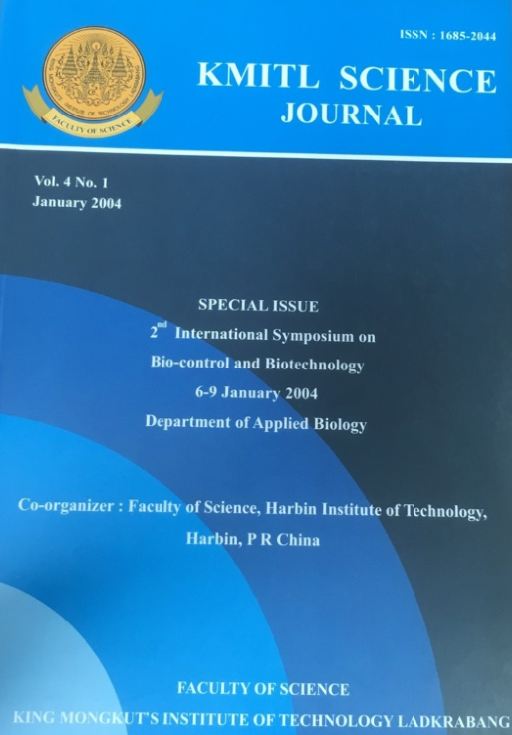The Detection of DNA Variation in Mutant “Sting-Broken Honeybees (Apis mellifera)” Induced by Gamma Radiation
Main Article Content
Abstract
Sting broken Apis mellifera was produced in Japan in order to prevent the allergy from bee stings and increase pollination. They are obtained by inducing gamma radiation to wild type A. mellifera at the larva stage. The difference between both type can not be detected at the development level. The size reduction in sting is visible after an abdomen dissection of sting broken workers. In order to avoid the death of sting broken bees, a method to detect the DNA variation between wild type Apis mellifera and sting broken honeybees was performed by using 6-MW primer (5’-CCGAC TCGAG NNNNN NATGT GG-3’), CTA4DOP primer (5’-CTACT ACTAC TACCG ACTCG AG-3’), and various RAPD primers (5’-GCATC GACTT-3’ as RAPD1; 5’-ACACT TCCCA-3’ as RADP2; 5’-GACGC TTGAC-3’ as RAPD3; 5’-CGATT CCCGT-3’ as RAPD4). The pattern of amplification was different between wild type A. mellifera and sting broken mutant. In addition, the high polymorphism of sting broken individuals as detected but in not wild type Apis mellifera individuals. DraI was used to cut genomic DNA of both. It seems that genomic DNA from wild type Apis mellifera was cut better. Genomic DNA library of both types of bees were successfully made. The result indicates the random effect of gamma radiation to the genome of the sting broken type. Although the DNA variation from both can be detected, the behavior of foraging is not different. At present, there are still many experiments to perform on sting broken honeybees before distributing to bee farming.
Keywords : -
Corresponding author: E-mail: cast@kmitl.ac.th
Article Details
Copyright Transfer Statement
The copyright of this article is transferred to Current Applied Science and Technology journal with effect if and when the article is accepted for publication. The copyright transfer covers the exclusive right to reproduce and distribute the article, including reprints, translations, photographic reproductions, electronic form (offline, online) or any other reproductions of similar nature.
The author warrants that this contribution is original and that he/she has full power to make this grant. The author signs for and accepts responsibility for releasing this material on behalf of any and all co-authors.
Here is the link for download: Copyright transfer form.pdf
References
[2] A. Bolzer, J.M. Craig, T. Cremer and M.R. Speicher, A Complete Set of Repeat-depleted, PCR-amplifiable, Human Chromosome Specific Painting Probes, Cytogenetics and Cell Genetics, 84, 1999, 233-240.
[3] N. Sarker, R.J. Hawken, S. Takahashi, L.J. Alexander and T. Awata, Directed Isolation and Mapping of Microsatellites from Swine Chromosome 1q Telometric Region Through Microdissection and RH Mapping, Mammalian Genome 12, 2001, 524-527.
[4] H. Telenius, N.P. Carter, C.E. Bebb, M. Nordenskjold and B.A. Ponder, Degenerate Oligonucleotide-primed PCR: General Amplification of Target DNA by a Single Degenerate Primer, Genomics, 13, 1992, 718-725.


